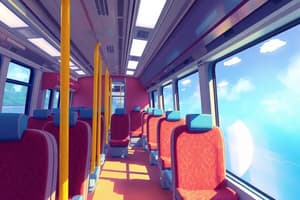Podcast
Questions and Answers
What is the primary focus of AUTOSAR Classic?
What is the primary focus of AUTOSAR Classic?
- Communication stack
- Vehicle computer architecture
- Application layer (correct)
- Physical layer
Which component of AUTOSAR Classic provides a platform for executing automotive applications?
Which component of AUTOSAR Classic provides a platform for executing automotive applications?
- Vehicle Computer
- Runtime Environment (RTE) (correct)
- Application Software (ASW)
- Basic Software (BSW)
What is the primary function of the Vehicle Computer in an AUTOSAR system?
What is the primary function of the Vehicle Computer in an AUTOSAR system?
- Control the physical layer
- Integrate various automotive systems (correct)
- Manage communication between nodes
- Provide a platform for automotive applications
Which layer of the Communication Stack defines the physical communication medium?
Which layer of the Communication Stack defines the physical communication medium?
What is the primary benefit of AUTOSAR as an open standard for automotive software architecture?
What is the primary benefit of AUTOSAR as an open standard for automotive software architecture?
What is the role of the Basic Software (BSW) in AUTOSAR Classic?
What is the role of the Basic Software (BSW) in AUTOSAR Classic?
Which of the following is a key feature of the Vehicle Computer in an AUTOSAR system?
Which of the following is a key feature of the Vehicle Computer in an AUTOSAR system?
What is the primary function of the Data Link Layer in the Communication Stack?
What is the primary function of the Data Link Layer in the Communication Stack?
Which AUTOSAR component provides automotive-specific applications?
Which AUTOSAR component provides automotive-specific applications?
What is the primary benefit of using AUTOSAR as a software architecture for automotive systems?
What is the primary benefit of using AUTOSAR as a software architecture for automotive systems?
Flashcards
AUTOSAR
AUTOSAR
An open standard for automotive software architecture, offering a common infrastructure.
AUTOSAR Classic
AUTOSAR Classic
A specification focusing on the application layer, providing APIs and interfaces for automotive applications.
Runtime Environment (RTE)
Runtime Environment (RTE)
Platform for executing automotive applications within AUTOSAR Classic.
Basic Software (BSW)
Basic Software (BSW)
Signup and view all the flashcards
Application Software (ASW)
Application Software (ASW)
Signup and view all the flashcards
Vehicle Computer
Vehicle Computer
Signup and view all the flashcards
Communication Stack
Communication Stack
Signup and view all the flashcards
Physical Layer
Physical Layer
Signup and view all the flashcards
Data Link Layer
Data Link Layer
Signup and view all the flashcards
Network Layer
Network Layer
Signup and view all the flashcards
Study Notes
AUTOSAR Overview
- AUTOSAR (Automotive Open System Architecture) is an open standard for automotive software architecture
- It provides a common infrastructure for automotive systems, enabling scalability, flexibility, and maintainability
AUTOSAR Classic
- AUTOSAR Classic is a specification for automotive systems, focusing on the application layer
- It provides a set of APIs and interfaces for automotive applications
- Key components:
- Runtime Environment (RTE): provides a platform for executing automotive applications
- Basic Software (BSW): provides a set of basic software modules for automotive systems
- Application Software (ASW): provides automotive-specific applications
Vehicle Computer
- A Vehicle Computer is a central computing platform in an AUTOSAR system
- It integrates various automotive systems, such as powertrain, safety, and infotainment
- Key features:
- High-performance computing
- Real-time operating system
- Support for multiple automotive busses (e.g., CAN, LIN, FlexRay)
Communication Stack
- The Communication Stack is a key component of AUTOSAR, enabling communication between automotive systems
- It consists of three layers:
- Physical Layer: defines the physical communication medium (e.g., CAN, LIN, FlexRay)
- Data Link Layer: provides error-free data transfer between nodes
- Network Layer: routes data between nodes and manages network topology
- Key protocols:
- CAN (Controller Area Network)
- LIN (Local Interconnect Network)
- FlexRay (high-speed communication protocol)
Software Architecture
- AUTOSAR Software Architecture is based on a layered architecture
- Key layers:
- Application Layer: provides automotive-specific applications
- Runtime Environment Layer: provides a platform for executing applications
- Basic Software Layer: provides basic software modules for automotive systems
- Microcontroller Abstraction Layer: provides a interface to the underlying microcontroller
- Key benefits:
- Scalability and flexibility
- Reusability of software components
- Improved system maintainability and reliability
AUTOSAR Overview
- AUTOSAR is an open standard for automotive software architecture, providing a common infrastructure for automotive systems
- The standard enables scalability, flexibility, and maintainability in automotive systems
AUTOSAR Classic
- AUTOSAR Classic is a specification for automotive systems, focusing on the application layer
- It provides a set of APIs and interfaces for automotive applications
- Runtime Environment (RTE) provides a platform for executing automotive applications
- Basic Software (BSW) provides a set of basic software modules for automotive systems
- Application Software (ASW) provides automotive-specific applications
Vehicle Computer
- A Vehicle Computer is a central computing platform in an AUTOSAR system
- It integrates various automotive systems, such as powertrain, safety, and infotainment
- High-performance computing is a key feature of a Vehicle Computer
- The Vehicle Computer uses a real-time operating system
- It supports multiple automotive busses, including CAN, LIN, and FlexRay
Communication Stack
- The Communication Stack enables communication between automotive systems
- The stack consists of three layers: Physical, Data Link, and Network
- The Physical Layer defines the physical communication medium, such as CAN, LIN, or FlexRay
- The Data Link Layer provides error-free data transfer between nodes
- The Network Layer routes data between nodes and manages network topology
- Key protocols used in the Communication Stack include CAN, LIN, and FlexRay
Software Architecture
- AUTOSAR Software Architecture is based on a layered architecture
- The Application Layer provides automotive-specific applications
- The Runtime Environment Layer provides a platform for executing applications
- The Basic Software Layer provides basic software modules for automotive systems
- The Microcontroller Abstraction Layer provides an interface to the underlying microcontroller
- The layered architecture enables scalability and flexibility
- It also allows for reusability of software components and improves system maintainability and reliability
Studying That Suits You
Use AI to generate personalized quizzes and flashcards to suit your learning preferences.



